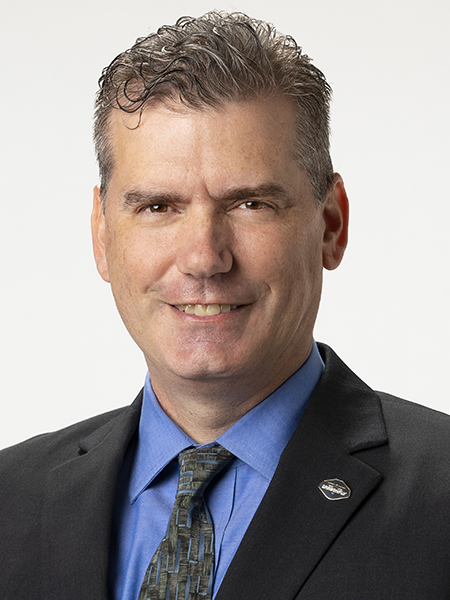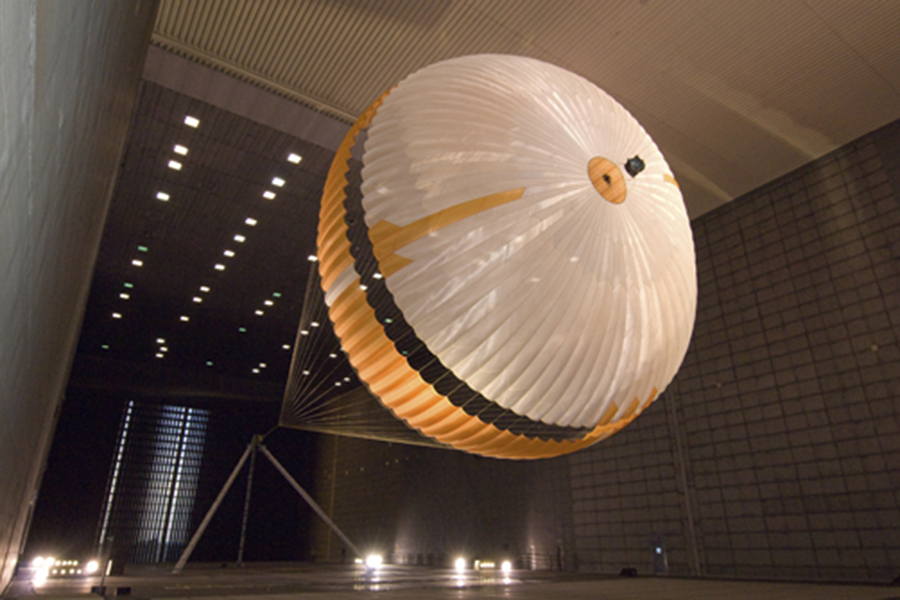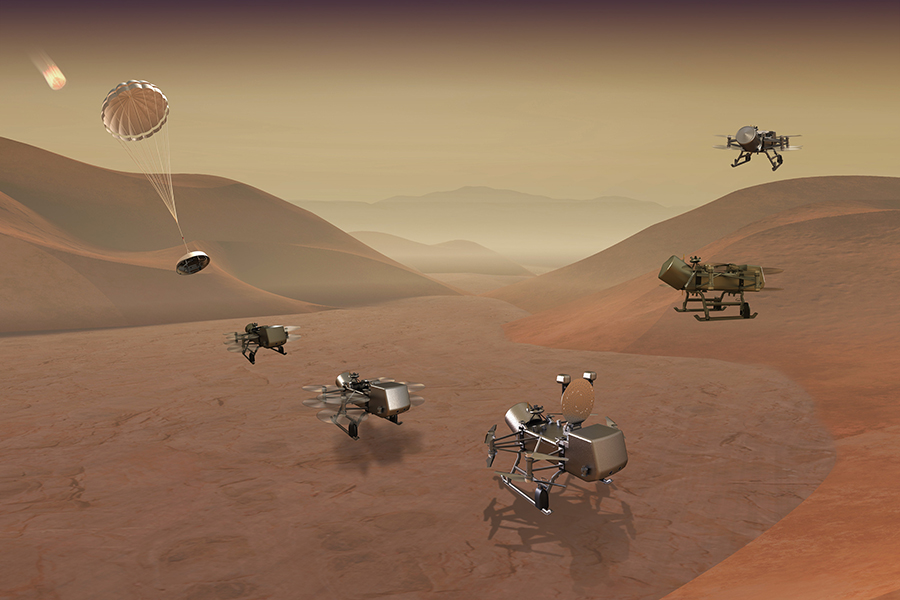Outstanding Aerospace Engineer Class of 2020: Doug Adams
Doug Adams was fascinated.
When his father handed him a National Geographic in January 1980, Adams soaked up the pages about Voyager, the twin spacecraft that had just encountered Jupiter. He pored over the details and later immersed himself in the encounters with Saturn, Uranus and Neptune, committing the clouds, rings, textures and craters of the planets and moons to memory. It was a tapestry of reality that was beyond imagination.
Adams, who had already been interested in space as an adolescent, found himself moved not just by the images, but the spirit of discovery, of experiencing something for the first time in human history.

“Wow, look at what we can do,” Adams thought when he saw the images. “We can really explore the deep reaches of space.”
His enthusiasm for discovery and desire to experience firsts only continued to grow.
By the time Adams identified aerospace engineering as his intended college major — he flirted with other engineering disciplines but couldn’t escape the wonder of space — Adams knew Purdue was the place.
During his time in the School of Aeronautics and Astronautics, Adams participated in the Cooperative Education program at NASA’s Johnson Space Center, which further solidified his passion for exploration and space.
After completing his Ph.D., Adams found projects that spoke to his core at NASA’s Jet Propulsion Laboratory (JPL), where he worked on the Mars Exploration Rovers, Spirit and Opportunity, the Phoenix Mars lander, and the Mars Science Laboratory rover, Curiosity, among numerous other projects.
Now, he’s part of a team working on Dragonfly, a mission that will send a rotorcraft lander to the surface of Titan, Saturn’s largest moon.
The Dragonfly mission, which is planned to launch in 2027 with a landing on Titan no earlier than 2034, will take Adams to the end of his career.
And what a perfect way to finish, with an opportunity to do exactly what inspired him as a kid growing up in Iowa — exploring never-seen environments, being responsible for traversing the surface of Titan for the very first time. But, much like the chronicle of Voyager’s journey in National Geographic, Adams is going to savor the moments along Dragonfly’s path, too.
“It’s kind of crazy to think about. I worked on four landed Mars missions, and supported both the InSight lander and the Mars 2020 rover, Perseverance. I also worked on two Mars spacecraft, Mars Reconnaissance Orbiter and Mars Express, and a number of other spacecraft all in the first half of my career, but in the last half of my career I’m going to work on just one. It’s only one, but it’s an amazing one,” Adams said.
“If it goes off the way I have it in envisioned in my head, I believe it will be a generational mission, not unlike Voyager.”
Only recently has Adams allowed himself to reflect on his career, about all the missions before Dragonfly and finishing with a flourish. The look back was prompted in early 2020 when Adams was selected as an Outstanding Aerospace Engineer, the highest honor bestowed upon alumni of the School of Aeronautics and Astronautics. COVID-19 postponed the initial OAE ceremony slated for April 2020, but the nine-member Class of 2020 will be honored in a virtual ceremony April 12, 2021.
“Being selected as an OAE is a great honor, and I am humbled by the experience,” he said. “It is truly the highlight of my career.”
For now, maybe. Another could be on the horizon in 15 or so years. But there already have been plenty of rewarding moments in a distinguished career to this point.
Few of them would have been possible without Purdue, which ideally prepared Adams for his career.
He took a breadth of courses in AAE but was especially sparked by the combination of 251 and 451, the sophomore- and senior-level design courses. The courses planted seeds about how problems needed to be solved — and how the different discipline areas worked together. When he was in a controls class, he would think about what mattered to a controls engineer. When he was in an aerodynamics class, he paid attention to the things that were sensitive to aerodynamicists. He was always thinking about the blending of those areas — and professors’ awareness of that blend came out in their teaching.
“They would make comments about how a particular topic mattered to other engineers and why you would make a decision one way or another,” Adams said. “It wasn’t just, ‘Oh, there’s a Bode plot.’ Instead they would ask, ‘Why do you care about this Bode plot? Why do you care about the controller’s bandwidth and where the poles and zeros are?’ For example, the structural engineers can’t give you an infinite frequency, but you still need to find a solution. They would bring the real world into the classroom. They would explain not just how to do what they were teaching you, but how what they were teaching you worked with other disciplines.
“It’s what I would call a grass-roots understanding of system engineering. I feel that’s one of the great things I got out of Purdue. When I started my professional career, I was often surprised by how myopic some people could be, exhibiting perceptions that indicated, ‘It’s all about my problem.’ Well, no, it’s not.”
While Adams was an undergrad, he decided he liked composite materials and wanted to study applied mechanics in graduate school. He researched where the best place would be to do so and found that Purdue had the best department in the country. So he stayed in West Lafayette and studied with C.T. Sun for his master’s and Ph.D.
His master’s research was with constrained viscoelastic layer damping. But by the time Adams was a doctoral student, Sun had won a large multi-university research grant from the Army, so Adams helped with that work studying interface defeat of long-rod penetrators. Adams investigated materials and high-strain rate fracture mechanics.
“You’re studying a subject, but what you’re learning is the tool, you’re learning the skill. That’s the beauty of it. If you pay attention to why you’re learning something, not just the particulars of what you’re learning, then that’s what you apply,” Adams said. “You can always go back and look it up in a textbook. But doing a Ph.D. gives you a deep exposure to the field. I’ve heard the anecdote, ‘You learn a lot about a little,’ and that’s a fun jest, but the truth is that in order to solve a problem, you read a great deal about tangential subjects to figure out how to extend the knowledge in one area. At least that’s what happened to me in my studies.”
That philosophy made him perfectly suited for his first job after Purdue.
One of Sun’s students worked at JPL, which was staffing up for the Mars Exploration Rover project. Adams’ resume got to the right people, and he got a call with a job offer.
“It turns out I was a perfect fit for what they were looking for,” he said. “My first office at JPL was in the Applied Mechanics Building. I laughed when I got there and saw that, thinking ‘I guess I’m in the right place.’ I later branched out in my career, but it was a natural starting place. Getting to work on the Mars Exploration Rovers, that was really a once-in-a-lifetime kind of thing. It was a very special project.”
More followed.
The Mars Science Laboratory (MSL) rover, Curiosity, was being developed at the same time Adams was working on the Phoenix Mars Lander. As part of his involvement with Phoenix, Adams directed the final stages of the parachute testing in the field, certifying their qualification for flight. He was never involved with the design of the parachute or even the preparation of it. But after Phoenix launched, the MSL team asked if he could take the reins of their parachute development.

“They said, ‘You worked on the parachute for Phoenix, right?’ I said, ‘Well, I made sure it was qualified,’” Adams said. “In the next sentence they asked, ‘How would you like to develop the parachute for MSL?’ I said, ‘OK.’”
Adams had never studied parachutes previously, which he referred to as a “black art” that “involves voodoo” because of their chaotic behavior. It’s a stochastic blend of anisotropic soft goods in a fluid-structure interaction that no one fully understands.
Yet Adams dove in to a multi-year experience that he called his “ashes to glory” story.
To test the parachute design, they needed to perform a mortar deployment test. A mortar is used to launch the packed parachute behind the entry vehicle so that it can open. In the second test at the National Full-Scale Aerodynamics Complex (NFAC), the parachute disintegrated. The team was left with a bag of rags.
They were pretty sure they knew what had happened — an inversion, when the wrong side of the parachute is exposed to the freestream flow and turns the parachute inside out — but they didn’t have proof. No one expected a failure to happen, so there weren’t any cameras suitable for forensics recording the test.
Over the course of 2008 they executed several tunnel entries at NFAC. On mortar deployment No. 8, they finally saw another failure. This time, they got it on tape. Somewhat ironically, they started high-fiving because they knew they would be able to watch it in exquisite detail and find out exactly what happened.
“Otherwise, you’d launch with this bogeyman,” Adams said. “But we caught the ghost on film.”
Adams realized that the issue, which was indeed an inversion, was a gravity-related problem. Because they were testing horizontally in Earth’s gravity, the parachute was falling sideways through the air in the thick terrestrial atmosphere and causing the inversions. They put anti-inversion netting on the parachute for testing, and it worked perfectly. The actual flight parachute didn’t require that feature, due to the different physics of a low-density supersonic deployment.
Despite the hiccup in testing, they were still able to deliver the parachute on schedule for a 2009 launch, which ultimately was postponed for other reasons. Curiosity eventually launched Nov. 26, 2011, and landed on Aug. 6, 2012.
But the mission wasn’t a success until Adams’ parachute did its job. And it had one chance.
Many other systems have backups or can carry margin against the unknown. The thermal protection system on the heatshield could be a bit thicker. The structure could be a bit stronger. They could carry a bit of extra propellant, just in case. But there was only one parachute.
On landing day, the team of engineers was together in a room watching telemetered data scroll across screens. Each major milestone was being announced, and once a certain set of conditions were met, the autonomous system would determine when to deploy the parachute. When that data displayed, Adams knew it could happen at any time. Then the announcement came, the parachute had been deployed. At exactly the same moment, the data stream blinked out.
“I was just frozen,” Adams said. “I’m thinking, ‘Parachute deploy? That doesn’t mean anything. Did it work?’”
The Doppler plot also was up on one of the screens, and it was still receiving the carrier signal from the spacecraft. Adams saw the Doppler shift take a sharp turn and knew that the only thing that could cause such a radical shift was a functioning parachute. A few seconds later, the data stream was back. All was well.
“I thought to myself, ‘Thank goodness, I get to keep my job,’” Adams said with a laugh. “That was a harrowing experience. There are other systems that if they fail, you’re in big trouble. But you’re rather exposed because everyone knows you’re in the box, they announce parachute deploy and everybody in the room turns and looks at you, it’s your parachute. But it worked, it worked beautifully, and we got a wonderful picture of it from the Mars Reconnaissance Orbiter.”
In 2013, Adams left JPL for family reasons and started at the Johns Hopkins Applied Physics Laboratory, which has offered him one of the most difficult and rewarding prospects of his career, Dragonfly.

The transition in itself was a challenge. Adams moved from subject matter expert — solving discipline problems — to defining global design in order to avoid problems. The work wasn’t on a funded project, but in a proposal environment. That meant less structure because the problem that was being solved was more nebulous, but there also was freedom to attack a problem in a way someone else may not have thought of.
It turned out to be a perfect environment for Adams because he could be creative and explore different avenues before the issues became cast in stone, which was largely in contrast to his previous experience.
And Adams needed to employ all of his problem-solving methods working on the Dragonfly proposal. He never worked harder in his life than in preparation for the NASA site visit. April 24, 2019, brought more than 50 reviewers.
For about 10 days before, and several weeks after, Adams and his team answered clarifying questions.
“Preparing for the site visit and responding to questions was exhausting,” he said. “We answered the very last question on May 10, and then it was surreal — we had worked so hard for so long, and suddenly there’s this cliff. You just stop like it’s the end of a race. Psychologically that’s challenging because you’re exhausted, and you walk around feeling like you’ve lost or forgotten something. You had to force yourself to admit that there was nothing more that could be done. There was quite literally no way for us to provide any more information.”
All they could do was wait to hear NASA’s decision. The assumption was the news wouldn’t come until after Apollo 11’s 50th anniversary celebration in July. So Adams wasn’t prepared when Zibi Turtle called him June 26, just after he’d boarded a plane at LAX.
“She says to me, ‘Doug, we won.’ And I cheerfully responded, ‘We won what?’ And then the magic words, ‘We won Dragonfly.’ It took her several tries to convince me we had actually won the mission. I just couldn’t believe it was true, after all that work and all that time,” he said of his conversation with Turtle, the Principal Investigator on Dragonfly.
In the time since, Adams has felt the electricity of the mission. As he talks about it, his voice raises, his words speed up.
“It immediately draws you in,” he said. “The human imagination is attracted to discovery. It’s fun. You could imagine being a member of the Apollo 8 crew, the first to see the opposing surface of the Moon. Or think of Galileo peering through his telescope, the first person to see the moons of Jupiter. The idea that you’re the first to see something, the first to do something, the discovery of something new is very endemic to the human psyche.
“Titan is a mysterious world and a scientifically fascinating place.”
Titan is the only other body in the solar system that has a hydrologic cycle, but it rains methane instead of water there. It has a subsurface water ocean. It has a nitrogen atmosphere. If it wasn’t so far from the sun, it could be inhabitable.
But Titan is shrouded in a thick atmosphere, which makes it impossible to image the surface from orbit. Radar images and thermal images can be taken, and have been, but those images are very low resolution, and they don’t allow viewing the way the human eye would see.
There are some images taken from Huygens, an ESA probe that was hosted by Cassini. Several were taken during the decent to the surface. But there is only one image taken from the surface.
“That’s it. That’s all we’ve seen of entire moon from the surface. That one image,” Adams said.
Dragonfly will offer so much more.
“We’re building a lander that can potentially traverse hundreds of kilometers on Titan,” Adams said. “There’s this kind of Superman theme, the idea that here’s this undiscovered horizon, this place no one has been to, no one has seen, and it’s not that you can land and take a picture, as good as that is, it’s that you fly and take movies. We can see the dunes flying underneath us. We pick our landing spots, and we set down and make scientific measurements. Then we’re off to another places that’s never been seen before.”
“It’s going to be a fascinating journey of exploration. It really is going to be amazing.”
